by Roger Blum
Jungle Diving
In the realm of jaguars, crocodiles and snakes
|
Yucatan, Mexico – here you can find jungle-covered temples, stunning nature and diving paradises. Where the word Yucatan comes from is heavily debated, but one theory is that it derives from the Mayan word Yakalpetén – the indigenous people’s name for the peninsula between the Gulf of Mexico and the Caribbean Sea. Literally, it means pearl at the neck of the earth. The longest barrier reef in the northern hemisphere and the second largest coral reef in the world are located here. The reef runs along the Mexican Caribbean coast past Belize to the east of the Honduran north coast. Divers from all over the world come to admire the famous coral reefs of Cozumel, the "cave of the sleeping sharks" on Isla Mujeres. Among the coral here, you can easily run into nurse sharks, and between May and September, it’s possible to find whale sharks and bull sharks from nearby Playa del Carmen.
|
|
In contrast, the rivers, lakes and huge marshes inland go almost unnoticed. It is paradise for water birds, frogs, reptiles, and aquatic mammals. Above all, the bodies of water provide a unique habitat for freshwater fish. Despite the variety of shapes, peculiarities and colourfulness of the freshwater fish, the inland areas attract much less attention from Mexico’s dive tourists than the coastal reef. The reason is that the freshwater areas are probably more difficult to access than the coral off the coast. Dense jungle, savannah and vast marshes have cut Yucatán off from the rest of Mexico for centuries. The Mayan ruins of Chichén Itzá, Uxmal, Tulum, and Coba among others in the area, have remained hidden by the jungle for hundreds of years, and were only gradually rediscovered and explored from the end of the 18th century onwards.
|
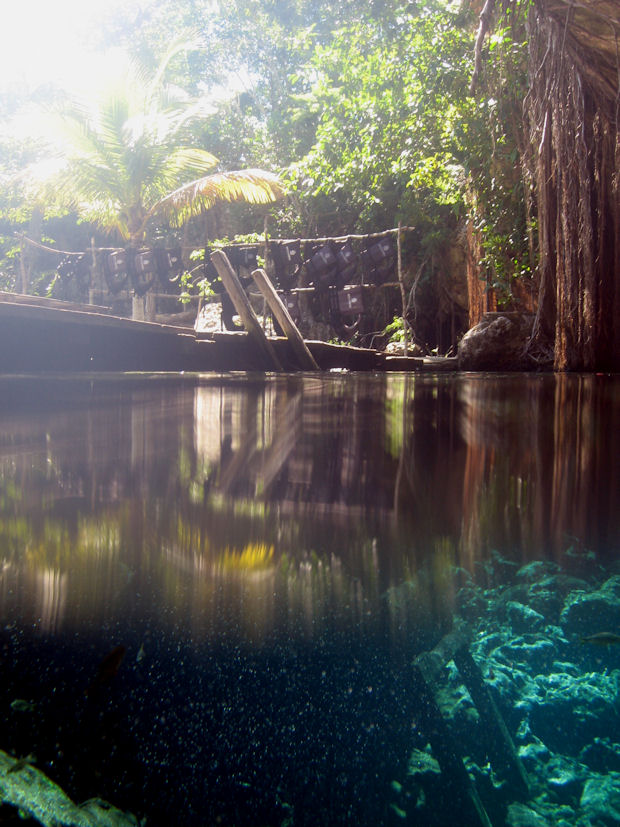 |
|
|
The peninsula is made mainly of limestone rock, interspersed with underground rivers, caves and ‘cenotes’. Cenotes - derived from the Mayan word "Dzenot" - are points of entry in the cave ceiling that lead into the underground networks of tunnels and limestone caves, packed with stalactites and stalactites. They offer cave divers a spectacular backdrop. Over 80 cave systems with more than 890 cenotes have already been discovered. The combined distance of all the investigated underwater cave systems comes, so far, to 994 km. The two longest systems - Ox Bel Ha and Sac Actun - are each accessible from more than 130 cenotes. The networks here are thought to be some of the largest adjoining underwater cave systems on earth.
|
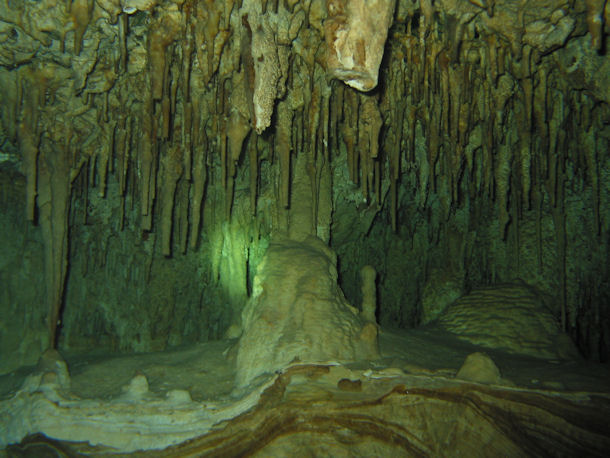 |
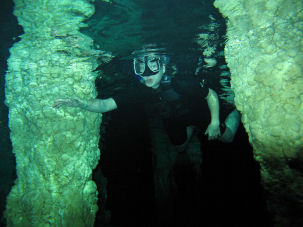 |
|
The Mayans regarded the Cenotes as the entrance to the underworld and used them as religious places of sacrifice. Offering objects such as statues, vessels, gold discs, jade and incense to the gods, the Mayans also sacrificed men, women and children. As priests recited prayers in honour of the rain god Chac, locals would push the bodies into the cenotes. A golden disc found in the Cenote de los Sacrificios in Chichén Itzá depicts such a scene: The victim is held down on his back while a priest cuts the heart out of his body with a knife. Next to the unearthed gold disc, plates of hammered gold covered with battle scenes were discovered, as well as masks and jewellery plaques. In addition, there were golden earrings, hundreds of cast copper bells, sacred wooden incense burners and spears, weaving tools, headgear and other fascinating archaeological artefacts.
|
In the realm of jaguars, crocodiles and snakes
Another treasure of the cenotes is the unique flora and fauna. During the dry season, the cenotes are often the only place for animals to find water and therefore inhabited by diverse fauna. The banks are the preferred meeting place for large mammals in the area. The Yucantan jungle is still home to the jaguar (Panthera onca), which hunts for the tapir (Tapirus bairdi) in the river valleys. While visiting as a tourist, you will only rarely run into these shy mammals, but there is a good chance of meeting a white nosed coati (Nasua narica). These animals from the family of the small bear are about 60 cm tall, have brown fur and striped tails. They live on the ground and in the trees in the lowlands. They are both good climbers and swimmers.
|
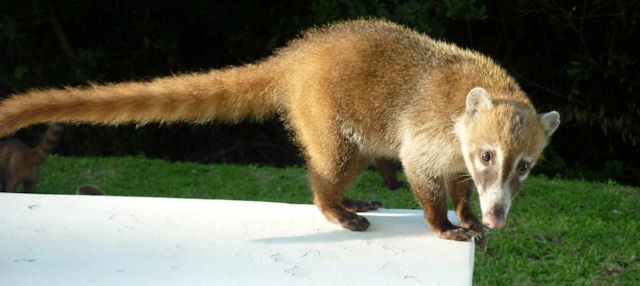 |
 |
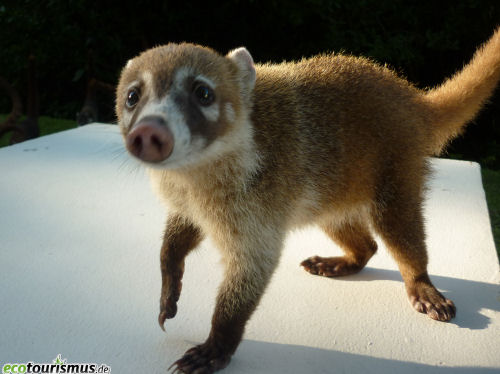 |
|
Yucatan is also the habitat of two crocodile species: the Crocodylus acutus and the Crocodylus moreletii. It is also possible to find Boa constrictors here. The Mayans believed that the world rested on the back of a large crocodile-like reptile in a water lily pond. The Mayan god Ah Puch (or Ah ouh puc) was also depicted as a crocodile. The idol was depicted as a skeleton with a crocodile’s back. He was the god of destruction and also considered to be the "Lord of the Six Hells".
|
The Boa (Boa constrictor) is only modestly sized in comparison to other large snakes, such as the reticulated python and Burmese python, and can reach lengths from 3–13 ft (1 - 4 m).
|
|
Diving into the Cenotes
In the cenotes you can also find colourful cichlids, tooth carp, catfish and tetras, which you may recognise from European aquariums, as well as small turtles. In fact, diving in the cenotes has been compared to swimming in a huge aquarium.
|
Cenote Kukulkan
The Cenote Kukulkan is located just south of Playa del Carmen nearby Puerto Aventuras. It is part of the Chac Mool cave system. The entrance to the cave is less than 50 m from the Cenote Chac Mool. The Kukulkan Cenote has a very large, light-flooded entrance where you can see crystal-clear, turquoise coloured water. This pool is located in a lush jungle environment and it’s perfect for snorkelling.
|
|
It’s possible for divers to use the Cenote Kukulkan as an entry into the subterranean network and the neighbouring Chac Mool as an exit. The underground cave system creates a common connection.
|
|
Entrance of Cenote Kukulkan
|
As you enter the sun-drenched cavern area, you will notice a large number of livebearing fish, potentially Gambusia yacatana or Poecilia sphenops. The fish are quite small, between three and five cm. They are constantly busy picking at the algae on the rocks. You can also find Guatemala antenna catfish (Rhamdia guatemalensis or Rhamdia quelen) and cichlids. The cichlids, around 10 cm long, are probably Jack Dempsey Rocio octofasciata. They swim in small groups in the light-flooded entrance area of the Cenote. Their fins, which are often very frayed, are dazzling.
Apparently, it’s also possible to find the species Amphilophus robertsoni in the Cenote Kukulkan. But I couldn’t identify any. However, in a secluded flat stretch of the cenote I encountered a loner, a Tilapia (Oreochromis sp.) about 40 cm tall. This particular species of cichlid was imported from Africa as fish food.
|
|
Jack Dempsey fish, Guatemala antenna catfish and Tilapia
|
|
You can also explore the cavern area of the cave with diving equipment without any problems. The water is crystal clear and the dimensions of the passageways are generous - between three and ten metres. It’s only now and then that you have to duck and pull stomach in to overcome a bottleneck. Even if it isn’t a problem to move through the network, diving in the cavern area of the caves can be disturbing for those with any form of claustrophobia. There are also forms of life in the cave area. Divers can encounter species of fish that have adapted to the area and become partially blind in the darkness of the cave.
|
|
Stalagmites and stalactites
|
Stop sign and the Grim Reaper
|
|
The cenote were formed during the ice ages in a phase of sinking sea levels. Water penetrated into the porous limestone and carbon dioxide dissolved in the water (as carbon dioxide) created cavities that have joined up over time. Due to the marine origin of the rock, fossils can often be found on the cave walls.
|
|
The effect of the lighting is impressive. When you dive back to the sun-drenched entrance area of the Cenote, you can encounter spectacular light shows. The entire entrance shines in a huge sheet of sunlight. The beautiful sunrays are very popular with photographers and videographers.
|
|
On the dark side of the cavern zone, there is a deep halocline. The Cenote Kukulkan has both a freshwater and saltwater layer due to its proximity to the sea and the porous rock structure. The layers do not mix. The lighter freshwater sits on top. The saltwater layer starts at a depth of about 10 m. In the border area between fresh and salt water, the so-called halocline, there are streaks running through the water that can considerably restrict visibility.
|
Cenote Chac Mool
The Cenote Chac Mool is located south of Playa del Carmen near Puerto Aventuras. There are two entrances. The Cenote Chac Mool and the Cenote Kukulkan are only a few meters away. Both the cenotes are connected by a tunnel and cave system. There are comfortable entry and exit points and platforms where you can rest. The entrance to Cenote Chac Mool can be reached via stairs and has a less sun-drenched area than the neighbouring Kukulkan. Already at a depth of three meters it starts to get dark and you have to feel the rock around you. Torchlight quickly gets lost in the clear infinity of the cave.
|
|
Entrance of Chac Mool Kukulkan with comfortable entry platform
|
|
|
In the cavern area you can see cichlids from the Rocio octofasciata species, as well as Guatemalan antenna catfish (Rhamdia guatemalensis) and live-bearing tooth carp from the species Gambusia yacatana and Poecilia sphenops. The black breed of this fish, dubbed "Black Molly", can be found in many German aquariums. Inside the cave you can discover blind shrimps of the Macrobrachium genus.
|
|
The diversity of species can probably be explained by the fact there aren’t any aggressive and predatory tetras Astyanax mexicanus to be found in the Cenote Chac Mool.
|
|
The cavern area of the Cenote, with its many stalactites and stalactites, is easy to explore even without cave-diving training. One special feature of the Cenote Chac Mool is an air-filled chamber (airdome) at the end of the cavern area. Here you can see large fossils on the cave ceiling, as well as spiders the size of a human hand living deep in the rock.
|
Cenote Dos Ojos
The Cenote Dos Ojos consists - as the name suggests - of two entrances about 100 m apart. Dos Ojos is also called "Two Eyes" and describes the two circular depressions in the jungle, also known as the Western and Eastern Eyes. The two magnificent semi-circular cenotes are large pools of crystal clear turquoise water that have formed around the edges of the collapse in the lush green jungle landscape.
|
|
The cenote is located 48 km south of Playa Del Carmen south of Xel-Ha on the right of road 307. Then 4 km down a dirt road into the jungle.
|
|
The Eastern Eye is also known as „Barbie Line“; the Western Eye as the „Bat Cave“. The entrance area is inhabited by many bats.
|
|
Cenotes Dos Ojos are probably the world's best cavern dives
|
Entrance of Cenote Dos Ojos
|
|
The fish fauna of Dos Ojos is quite limited in contrast to the other cenotes. Essentially the entire cavern area is inhabited only by characins of the species Astyanax mexicanus (previously Anoptichthys jordani). The common name of this freshwater fish is Mexican tetra or blind cave fish. Growing to a maximum total length of 12 cm (4.7 in), the Mexican tetra have very high body fat levels, are very starvation resistant and have symptoms reminiscent of human diseases such as diabetes and fatty liver disease. But the fish remain healthy and don't have any obvious health problems like we see in humans. It seems that the fish does have an insulin resistance. This could help yield new insights on diabetes and researchers can develop drugs that might help patients.
|
|

|
|
The tetra follow the divers and their lamps too. They enter the cave area and capture crustaceans, attack blind cave fish and eat their juveniles, which has a negative influence on the fauna of the cave.
The large tetra swarms attract the sleeper goby Gobiomorus dormitor. I noticed a 30 cm long specimen of this predator, which lurked under a wooden plank on his prey.
|
|
There are only a few livebearing fish of the genus Mollinesia in Dos Ojos. Livebearing carps are represented by Poecilia mexicana and Gambusia yucatana.
|
Gran Cenote
Gran Cenote - The name tells it all. Its the most popular Cenote in Tulum.
|
|
A small staircase down and you find yourselves with two stairwells into marvelous crystal clear, deep waters with great visibility. On the right side you can swim through a cave to another cenote pool.
|
|
The Gran Cenote is the main entrance of the cave system Sac Actun („White cavern). In early 2007, the underwater cave Sistema Nohoch Nah Chich was connected into and subsumed into Sac Actun making it the longest surveyed underwater cave system in the world. In 2018, a discovery of link between the Sac Actun system (reported to be 263 km long) and the Dos Ojos system in Tulum, Quintana Roo (84 km long) has been reported. The combined system is reported to be the world's largest underwater cave system known.
|
Beside Meso-American slider turtles (Trachemys venusta venusta) there are large populations of Poecilia mexicana, whose males here have gorgeous red fins. The tetras can be found here down to a depth of 13 metres. Furthermore there are Cichlasoma urophthalmus and Astatheros robertsoni, which I didn't have seen.
|
|
Another species of livebearers are Gambusia yucatana. The species is distributed from Mexico to Guatemala and Belize.
|
|
Unfortunately, the flora and fauna of the cenotes have received as of yet, little attention in most diving literature. I hope that this article makes the small contribution of shining a light on the unique world of the cenotes.
|
|
Freshwater fish of Latin America
|
|
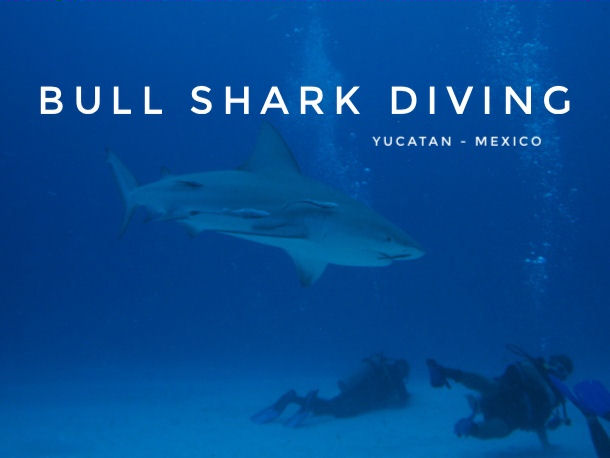
Meet The Bull Sharks
The real reason I went to Mexico was actually to photograph the fauna and flora in freshwater cavern areas far away from the ocean. Here in the jungle, there are colorful cichlids, tooth carp, catfish and tetrasa, all of which we know from our native aquariums, as well as blind cave fish and turtles. But I was drawn to the ocean when I was given the opportunity by a small group of adventurous divers to swim with bull sharks.
[read more]
|
|
|

The Airplane Wrecks of Renaissance Island (Aruba)
It is possible to find A Convair CV 240 lying some 300 meters off the shores of Aruba’s Renaissance Island at a depth of only 12 meters. This particular machine is said to have been confiscated at the end of the 1980s during a drug raid. Just a few breaststrokes away from the Convair wreck lies the remains of a former YS-11 passenger aircraft, one of three models employed by Air Aruba for scheduled flights in 1988. Following the bankruptcy of Air Aruba in October 2000, the YS-11 found a new purpose as an artificial reef.
[read more]
|
|
|
|

